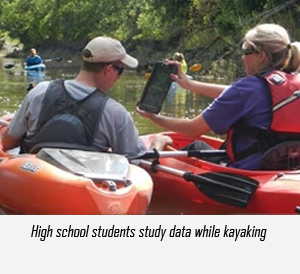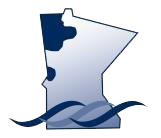River Watch Founder Looks Back at Two Decades of Watershed Education
The River Watch Forum held March 15, 2016 at the University of Minnesota Crookston campus marked the 21st Anniversary of the River Watch program. River Watch teams have played a significant role in providing scientifically sound data for assessing conditions of streams throughout the Red River Basin.
The Forum is always a popular event where River Watch teams summarize and showcase results from their river/stream monitoring efforts and demonstrate knowledge of their local watersheds.
At this year’s Forum, the man who started his work coordinating the River Watch program in 1995 was recognized with an award and appreciation for his extensive efforts by members of the Red River Watershed Management Board (RRWMB). Wayne Goeken, Special Projects Coordinator at the International Water Institute, began working on River Watch while he was the administrative assistant for the Sand Hill Watershed District, and also working at the Agassiz Environmental Learning Center in Fertile.
“They wanted to do a project on the Sand Hill River, and they didn’t have any water quality data…so we started with the Mississippi Headwaters Board, which was doing (its) River Watch at the time. They helped us get started,” said Goeken.
“We started borrowing equipment. At first, it was just to test water quality for the watersheds, but the Mississippi Headwaters Board was working with schools, so we realized that it was a good educational program to get the kids engaged with their watersheds, also. We kind of branched from there, starting with schools from the Sand Hill, and shared with more with the Red River Watershed Board. They understood the impact of it,” he said.
Through these efforts, Goeken recognized the need to educate new generations about the importance of the water that flows through the Basin, where it flows, and why water quality is important. In addition, he saw River Watch as an opportunity to teach kids skills in scientific investigation and presentations, which are necessary to access water quality and communicate the findings effectively.
Expansion Began Quickly
It didn’t take long for River Watch to start expanding through border water and soil resource grants, and local support from the RRWMB. Schools in the northern part of the Basin joined first. In 2001, River Watch started expanding to the south to include the whole RRWMB territory in the Red River Basin.
“It really comes down to the individual teachers that really make it happen, and they see the value as an educational component for their kids,” Goeken said. “It really crosses different curriculum areas. Also, the outdoors, the hands-on science, is something that they have found that really works well and the kids really like it.”

Through River Watch, students perform tests in local streams to determine dissolved oxygen, Ph and turbidity levels. Additional measurements and visual judgments supplement the test results. Then the data is shared on a computer network so students from other sites can compare results.
Recently, River Watch has expanded into more programs involving macroinvertebrates in rivers by analyzing initial physical and chemical parameters that students have tested. As a result, Goeken says students are seeing more connections to rivers, the impacts, and what water quality really means.
River Explorers Program
Over the last four years, the River Explorers Program has provided an opportunity for students, resource managers, and community participants to enjoy and explore rivers from the seat of a kayak. Participants have mixed kayaking with high-tech tools for exploration and documentation of local river conditions.
The information gathered from the river trips can be used by local resource managers and the public as it provides a unique on-the-water perspective of local river conditions. It can also be used in the development of management strategies to protect and improve the watershed.
“Other than just going to spots along river crossings at a bridge or culvert and taking a snapshot of the water quality, we get them out on the water so they can see upstream or downstream of those spots to see what’s causing the water quality,” said Goeken.
Goeken will scout the kayaking locations before bringing students along, which for him is far from a tedious job. “It's all very interesting, just to see the dynamics of the river changing from season to season, and the rain events we get and how they impact the rivers so dramatically, and recognizing all of the safety aspects that factor in and make sure you’re cognizant of before you take any students out,” he said.
River Explorers also offers the perfect opportunity for students to enjoy outdoor recreation on local rivers. “A lot of these kids have never been out in a kayak or canoe, or certainly never thought about their local river as a recreation possibility,” Goeken said.
The theme of this year’s River Watch Forum was River Recreation. The posters submitted by students were related to the rivers in their local communities, and promoted rivers as assets.
River Watch is also teaching fourth graders about where they sit in the watershed. “Our staff works at water festivals also and works with different grades at that point, as well,” said Goeken. “We’ve expanded from our initial, basic water quality monitoring into more water awareness, engagement activities and opportunities, and we’ve had good support continued from the watershed districts and the Minnesota legislature has provided funding. In North Dakota, we’re starting to expand, too.”
Concurrent sessions are also held where students can also learn from other water resource professionals. These sessions offer perspective to high school students who are looking for career opportunities.
Future Decision-Makers
The environmental education aspects of getting kids involved and looking for a future always appealed to Goeken. Today, he is gratified that he was able to play a significant role in igniting an interest for watersheds in kids. “These are our future decision-makers who will need to take care of this landscape. We're getting to the point where we could have another generation coming up through the program and it's really neat. Some of the schools where you may have three to five kids from the same family have been in River Watch over the years. They must be doing something right if they want to keep at it and, for instance, talk with a younger brother or sister about getting involved in the program. It's pretty neat.”
Search our
Web-site!
Contact the RRWMB
Address: P.O. Box 763 | Detroit Lakes, MN 56502
Telephone: (218) 844-6166
FAX: (218) 844-6167
E-mail: rrwmb@arvig.net


